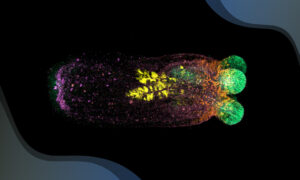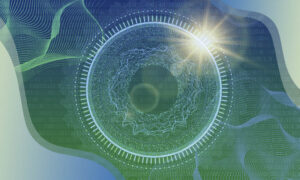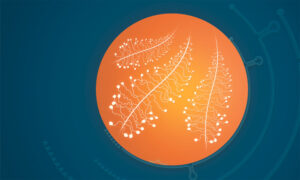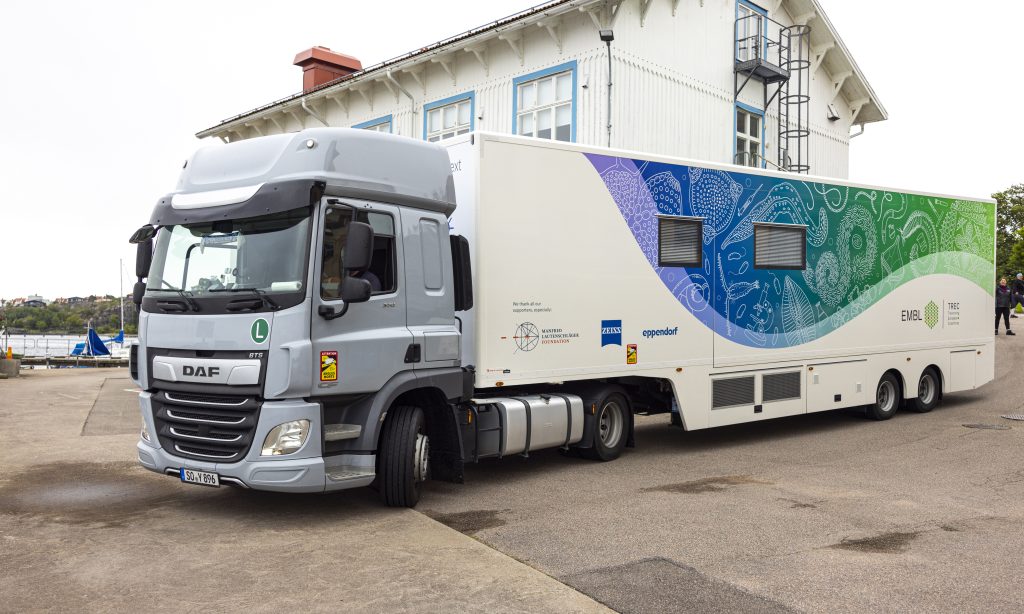Read the latest Issue
Understanding soil through its microbiome
First global survey of soil genomics reveals a war between fungi and bacteria
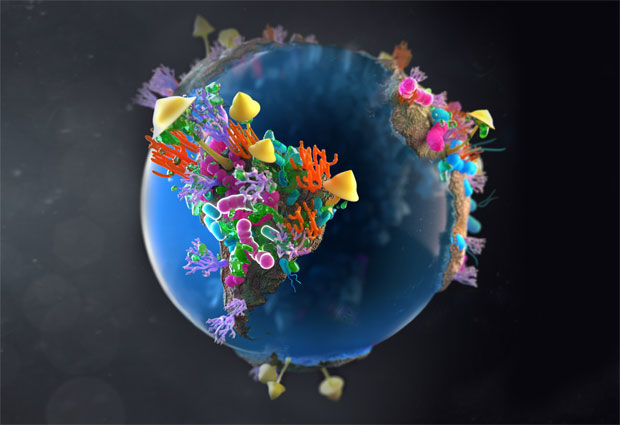
Soil is full of life, essential for nutrient cycling and carbon storage. To better understand how it functions, an international research team led by EMBL and the University of Tartu (Estonia) conducted the first global study of bacteria and fungi in soil. Their results show that bacteria and fungi are in constant competition for nutrients and produce an arsenal of antibiotics to gain an advantage over one another. The study can also help predict the impact of climate change on soil, and help us make better use of natural soil components in agriculture. Nature publishes the results on 1 August 2018.
Research on the soil microbiome requires scientists to get their hands dirty. Over the course of five years, 58.000 soil samples were collected from 1450 sites all over the world (40 subsamples per site), that were carefully selected to be unaffected by human activities such as agriculture. First authors Mohamad Bahram (University of Tartu) and Falk Hildebrand (EMBL), together with a large team of collaborators, set up this massive project, gathered samples, and analysed the 14.2 terabyte dataset. Of the 1450 sites sampled, 189 were selected for in-depth analysis, covering the world’s most important biomes, from tropical forests to tundra, on all continents.

Global microbial war in soil
Only half a percent of the millions of genes found in this study overlapped with existing data from gut and ocean microbiomes. “The amount of unknown genes is overwhelming, but the ones we can interpret clearly point to a global war between bacteria and fungi in soil,” says Peer Bork, EMBL group leader and corresponding author of the paper.
Overall, the bacterial diversity in soil is lower if there are relatively more fungi. The team also found a strong link between the number of antibiotic resistance genes in bacteria and the amount of fungi, especially those with potential for antibiotics production such as Penicillium. Falk Hildebrand: “This pattern could well be explained by the fact that fungi produce antibiotics in warfare with bacteria, and only bacteria with adequate antibiotic resistance genes can survive this.”
“The antagonism between fungi and bacteria influences the overall diversity of bacterial communities and determines their genetic repertoire of antibiotic resistance”, says Mohamad Bahram. This information can be used to predict the spread of genes that lead to antibiotic resistance in different ecosystems, and via what routes they may reach human pathogens. It could also help predict and pinpoint locations with high levels of natural antibiotics producers.
Regional differences
The team also found regional differences in the distribution of bacteria and fungi. Bacteria are everywhere, with the highest genetic diversity in temperate zones with a moderate climate. Environmental factors such as temperature are most decisive in their relative abundance: they often prefer hot and wet locations. Fungi are usually more prevalent in colder and dryer climates like the tundra. They also tend to be more geographically restricted, with differences in populations between continents. This implies that the relative contributions of bacteria and fungi to nutrient cycling are different around the world, and that global climate change may affect their composition and function differently.
Effects of human activity
When comparing data from the unspoiled soil sites with data from locations affected by humans, such as farmland or garden lawns, the ratios between bacteria, fungi and antibiotics were completely different. According to the scientists, this shift in the natural balance – that probably evolved over most of the earth’s history – shows the effect of human activities on the soil microbiome, with unknown consequences so far. However, a better understanding of the interactions between fungi and bacteria in soil could help to reduce the usage of soil fertilizer in agriculture, as one could give beneficial microorganisms a better chance at survival in their natural environment.
Das Mikrobiom als Schlüssel zum Verständnis des Bodens
Zwischen Pilzen und Bakterien in der Erde herrscht ein permanenter Wettkampf, wie die erste weltweite Untersuchung der Bodengenomik aufzeigt
Der Boden steckt voller Leben, was entscheidend für den globalen Nährstoffkreislauf und die Kohlenstoffanreicherung ist. Um die Prozesse innerhalb des Bodens besser zu verstehen, führte ein internationales Forschungsteam unter Leitung des EMBL und der Universität Tartu (Estland) die erste weltweite Untersuchung von Bakterien und Pilzen durch. Diese Daten zeigten, dass Bakterien und Pilze in ständigem Wettbewerb um Nährstoffe stehen. Unter anderem werden mikrobiell produzierte Antibiotika benutzt, um sich einen Vorteil gegenüber den konkurrierenden Stämmen zu verschaffen. Diese Untersuchung kann dazu beitragen, natürliche vorkommende Mikroben besser in der Landwirtschaft zu nutzen und die Auswirkungen des Klimawandels auf die Erdmikrosphäre genauer vorherzusagen. Das Fachmagazin Nature veröffentlicht die Ergebnisse am 01 August.

Bei der Erforschung des Bodenmikrobioms müssen sich die Wissenschaftler die Hände schmutzig machen. Über fünf Jahre hinweg entnahmen sie 58.000 Bodenproben an 1.450 Standorten auf der ganzen Welt (40 Teilproben pro Standort); die Standorte wurden danach ausgewählt, ob sie von menschlichen Aktivitäten wie der Landwirtschaft unbeeinflusst waren. Mohamad Bahram (Universität Tartu) und Falk Hildebrand (EMBL) haben dieses gigantische Projekt zusammen mit einem großen Team von Kooperationspartnern ins Leben gerufen. Sie haben Proben gesammelt und den 14,2 Terabyte großen Datensatz bioinformatisch ausgewertet, und sich dabei auf 189 / 1.450 Bodenproben für eine detaillierte Analyse konzentriert (siehe Abbildung 1), welche die wichtigsten Biome der Welt, von Tropenwäldern bis zur Tundra, auf allen Kontinenten umfasst.

Globaler Kampf der Mikroben um Ressourcen
Während die Studie viele Millionen Gene der Mirkoben analysierte, überlappte lediglich ein halbes Prozent dieser mit Genen in den internationalen Datenbanken auf. „Die schiere Menge bisher unbekannter Gene ist überwältigend, aber diejenigen, die wir interpretieren können, weisen eindeutig auf einen globalen Krieg zwischen Bodenbakterien und -pilzen hin”, sagt Peer Bork, EMBL-Gruppenleiter und Korrespondenzautor des Artikels.
Wie die Forscher entdeckten, kommen weniger Bakterien im Boden vor, wenn mehr Pilze vorhanden sind. Das Team stellte einen starken Zusammenhang zwischen der Anzahl von bakteriellen Antibiotikaresistenzgenen in Bakterien und der Menge von Pilzen fest. Insbesondere trifft dies in der Gegenwart von Pilzen zu, die zur Bildung von Antibiotika in der Lage sind, wie etwa Penicillium. „Dieses Muster“, so Falk Hildebrand, „könnte dadurch erklärt werden, dass Pilze im Kampf um mehr Ressourcen Antibiotika produzieren, wodurch nur Bakterien mit den entsprechenden Antibiotikaresistenzgenen überleben und so den Pilzen einen Vorteil verschafft.”
Der Antagonismus zwischen Pilzen und Bakterien beeinflusst die Vielfalt bakterieller Gemeinschaften und bestimmt deren genetisches Repertoire an Antibiotikaresistenzen. Dieses Verständnis kann zur Vorhersage genutzt werden, wie sich Antibiotikaresistenzgene verbreiten und über welche Wege sie menschliche Krankheitserreger erreichen. Außerdem können sie genutzt werden, um Orte mit einem hohen Anteil an natürlichen Antibiotikaproduzenten vorherzusagen. Das ist wichtig, um neue Antibiotika zu finden.
Regionale Unterschiede
Das Team stellte überdies regionale Unterschiede in der Verteilung von Bakterien und Pilzen fest. Bodenbakterien finden sich überall; die größte genetische Vielfalt erreichen sie jedoch in gemäßigten Klimazonen. Ausschlaggebend für ihre relative Häufigkeit sind Umweltfaktoren wie die Temperatur: sie bevorzugen oft warme und feuchte Standorte. Pilze hingegen kommen häufiger in kühlen und trockenen Klimazonen wie der Tundra vor. Außerdem sind sie oft stärker geografisch beschränkt, das heißt es bestehen häufiger Populationsunterschiede zwischen den Kontinenten. Daraus folgt, dass die relativen Beiträge von Bakterien und Pilzen zum Nährstoffkreislauf weltweit unterschiedlich sind, sodass der globale Klimawandel sich unterschiedlich auf ihre Zusammensetzung und Funktion auswirken könnte.
Auswirkungen menschlicher Aktivität
Vergleicht man die Daten der unberührten Bodenstandorte mit den Daten der vom Menschen beeinflussten Orte wie z.B. Ackerland oder Gartenrasen, fällt auf, dass völlig unterschiedliche Verhältnisse zwischen Bakterien, Pilzen und Antibiotikaresistenzen bestehen. Diese Verschiebung des natürlichen Gleichgewichts – das sich vermutlich über weite Teile der Erdgeschichte evolviert hat – zeigt, nach Ansicht der Wissenschaftler, die Auswirkungen menschlicher Aktivitäten auf das Bodenmikrobiom, mit bisher unbekannten Folgen. Ein besseres Verständnis der Wechselwirkungen zwischen Pilzen und Bakterien im Boden könnte jedoch dazu beitragen, den Einsatz von Bodendünger in der Landwirtschaft zu reduzieren. Nützlichen Mikroorganismen würde dadurch eine höhere Überlebenschance in ihrer natürlichen Umgebung verschafft.
Entender el suelo a través de su microbioma
Primer estudio mundial de genómica del suelo revela una batalla entre hongos y bacterias
El suelo está repleto de vida, es esencial para el ciclo de los nutrientes y el almacenamiento de carbono. Para comprender aún mejor cómo funciona, un equipo internacional de investigadores, liderados por el Laboratorio Europeo de Biología Molecular (EMBL, por sus siglas en inglés) y la Universidad de Tartu (Estonia), han llevado a cabo el primer estudio de hongos y bacterias en el suelo. Los resultados revelan que hongos y bacterias compiten constantemente por adquirir nutrientes y producen un arsenal de antibióticos para obtener ventajas los unos sobre los otros. El estudio puede contribuir a predecir el impacto del cambio climático en el suelo y ayudarnos a darle un mejor uso a los componentes naturales del suelo en la agricultura. La revista Nature publica los resultados el 1 de agosto de 2018.

Para estudiar el microbioma del suelo, los científicos deben ensuciarse las manos. En el transcurso de cinco años, se reunieron 58 000 muestras de suelo provenientes de 1 450 sitios en todo el mundo (40 submuestras por sitio), seleccionando cuidadosamente lugares no afectadas por actividades humanas como la agricultura. Los autores principales, Mohamad Bahram (Universidad de Tartu) y Falk Hildebrand (EMBL), junto a un gran grupo de colaboradores, pusieron en marcha el proyecto, reunieron las muestras y analizaron el volumen de datos de 14,2 terabytes. De los 1 450 sitios muestreados, se seleccionaron 189 para realizar un análisis en profundidad, abarcando los biomas más importantes del mundo, desde selvas tropicales hasta la tundra, en todos los continentes.

Batalla microbiana global
Tan solo medio punto porcentual de los millones de genes encontrados en este estudio coincide con información existente proveniente de microbiomas humanos u oceánicos. «La cantidad de genes desconocidos es asombrosa, pero aquellos que podemos interpretar señalan indudablemente que se está librando una batalla global entre los hongos y las bacterias del suelo», comenta Peer Bork, líder del grupo de EMBL y autor para correspondencia del estudio.
En general, la diversidad bacteriana del suelo es menor si la proporción de hongos es mayor. El equipo identificó, además, un estrecho vínculo entre el número de genes de resistencia a los antibióticos que poseen las bacterias y la cantidad de hongos, en especial aquellos con potencial para producir antibióticos tales como el género de hongo Penicillium. Falk Hildebrand: «Este patrón podría explicarse teniendo en cuenta que los hongos producen antibióticos para combatir a las bacterias, y solo aquellas que posean genes de resistencia a los antibióticos pueden sobrevivir».
El conflicto entre los hongos y las bacterias incide sobre la diversidad total de comunidades bacterianas y determina el repertorio genético de resistencia a los antibióticos. Esta información puede utilizarse para predecir la proliferación de genes que originen una resistencia a los antibióticos en diferentes ecosistemas y el medio por el cual podrían llegar a los agentes patógenos humanos. Además, podría ayudar a predecir e identificar regiones con una marcada presencia de productores naturales de antibióticos.
Diferencias regionales
El equipo también encontró diferencias regionales en la distribución de bacterias y hongos. Las bacterias se encuentran presentes en todos lados, y presentan la más alta diversidad genética en zonas templadas con clima moderado. Factores ambientales tales como la temperatura determinan en forma decisiva su abundancia: generalmente prefieren sitios calurosos y húmedos. Los hongos suelen abundar en climas más fríos y secos como la tundra. También tienden a estar más limitados geográficamente —las poblaciones varían según el continente. Esto significa que las contribuciones relativas de bacterias y hongos al ciclo de nutrientes varían en todo el mundo, y que el cambio climático global podría afectar su composición y funcionamiento de diferente modo.
Efectos de la actividad humana
Al comparar información de sitios con suelos vírgenes con información proveniente de sitios intervenidos por humanos, como granjas o jardines, la proporción de bacterias, hongos y antibióticos reveló ser completamente distinta. Según los científicos, esta alteración en el equilibrio natural (que probablemente ha evolucionado durante gran parte de la historia de la Tierra), denota el efecto de las actividades humanas en el microbioma del suelo, cuyas consecuencias son aún desconocidas. Sin embargo, comprender en mayor profundidad las interacciones entre los hongos y las bacterias en el suelo podría ayudar a reducir el uso de fertilizantes en agricultura y así darles a los microorganismos beneficiosos la posibilidad de sobrevivir en su ambiente natural.

